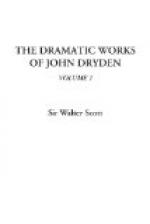When Dryden had but just finished his “Religio Laici,” Lee, who had assisted in the play of “Oedipus,” claimed Dryden’s promise to requite the obligation. It has been already noticed, that Dryden had, in the year succeeding the Restoration, designed a play on the subject of the Duke of Guise; and he has informed us he had preserved one or two of the scenes. These, therefore, were revised, and inserted in the new play, of which Dryden wrote the first scene, the whole fourth act, and great part of the fifth. Lee composed the rest of “The Duke Of Guise.” The general parallel between the League in France and the Covenant in England, was too obvious to escape early notice; but the return of Monmouth to England against the king’s express command, in order to head the opposition, perhaps the insurrection, of London, presented a still closer analogy to the entry of the Duke of Guise into Paris, under similar circumstances, on the famous day of the barricades. Of this remarkable incident, the united authors of “The Duke of Guise” naturally availed themselves; though with such precaution, that almost the very expressions of the scene are taken from the prose of Davila. Yet the plot, though capable of an application so favourable for the royal party, contained circumstances of offence to it. If the parallel between Guise and Monmouth was on the one hand felicitous, as pointing out the nature of the Duke’s designs, the moral was revolting, as seeming to recommend the assassination of Charles’s favourite son. The king also loved Monmouth to the very last; and was slow and reluctant in permitting his character to be placed in a criminal or odious point of view.[34] The play, therefore, though ready for exhibition before midsummer 1682, remained in the hands of Arlington the lord-chamberlain for two months without being licensed for representation. But during that time the scene darkened. The king had so far suppressed his tenderness for Monmouth, as to authorise his arrest at Stafford; and the influence of the Duke of York at court became daily more predominant. Among other evident tokens that no measures were hence-forward to be kept between the king and Monmouth, the representation of “The Duke of Guise” was at length authorised.




